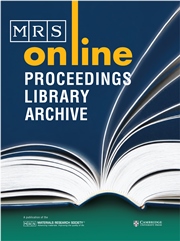Article contents
Co3O4 Epitaxial Formation on CoO(100)
Published online by Cambridge University Press: 21 February 2011
Abstract
Co3O4 epitaxies grow readily on cobalt monoxide substrates under a wide range of oxidizing pretreatment conditions. The nucleation and growth of Co3O4 on CoO(lOO) have been investigated by XPS, HREELS and LEED. Both rocksalt CoO and spinel Co3O4 share the geometric characteristic of closest packed lattice O2+ with oxygen to oxygen distances that match to within 5%. We propose a mechanism whereby the Co2+ move from octahedral CoO(100) surface sites to bridging O2- -O2-, positions that correspond to tetrahedral Co2+ sites in the spinel. Oxygen added to the surface finds its way into the near-surface region both as lattice O2-, chemically indistinguishable in CoO and Co3O4, and as excess surface oxygen. The excess oxygen, which gives an XPS binding energy of 531.6 eV and a HREELS signature at 137 meV (1100 cm-1) identifies it as a superoxo species. This species can be added and removed reversibly from the surface by annealing under oxidizing/UHV reducing conditions.
- Type
- Research Article
- Information
- Copyright
- Copyright © Materials Research Society 1995
References
REFERENCES
- 1
- Cited by


